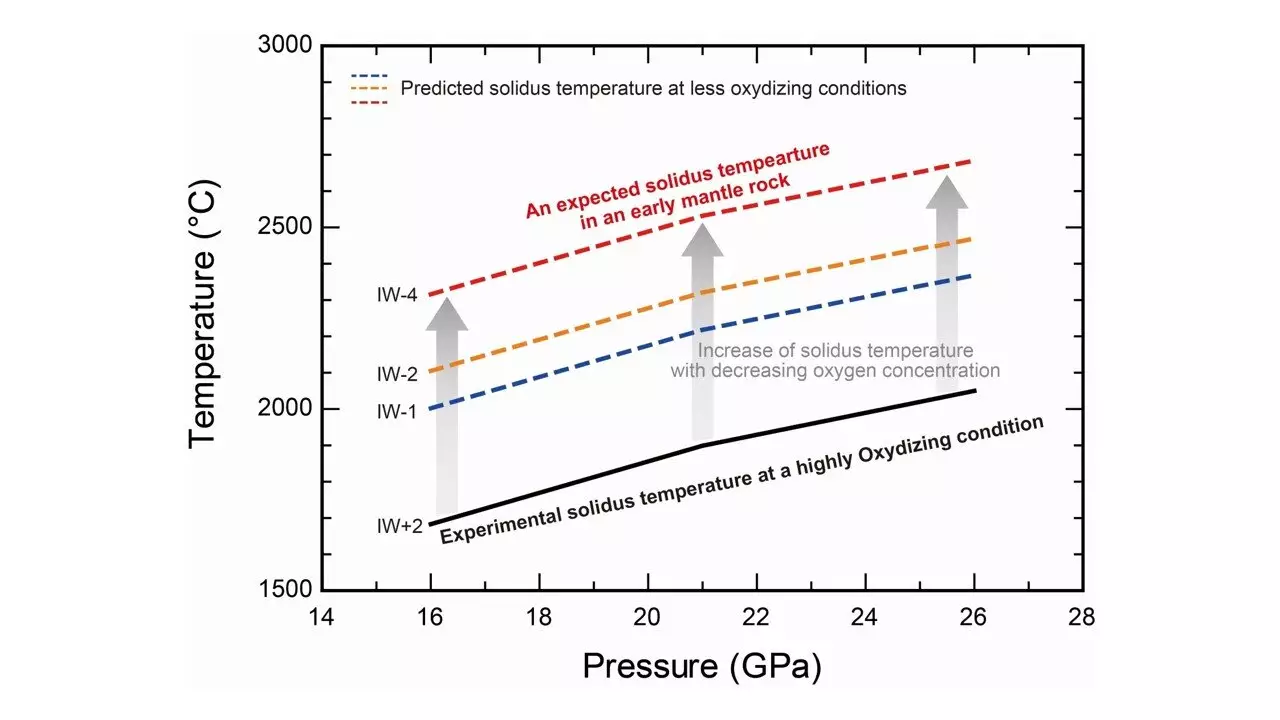The formation of Earth represents one of the most intriguing narratives in planetary science, marked by a multitude of dynamic processes that set the stage for the planet we inhabit today. Initially, scientists posit that the early Earth was dominated by a colossal expanse of molten magma—a ‘magma ocean.’ This state of the planet is attributed to intense heat generated through accretionary impacts with smaller celestial bodies. However, our understanding of this formative phase is riddled with uncertainties, particularly regarding the precise melting temperatures of deep mantle rocks, which are essential to modeling the formation of this magma ocean.
Traditionally, models have depended on a set of experimental data to estimate the melting temperatures of the Earth’s mantle. Interestingly, recent advancements in experimental techniques suggest that previous estimations may have missed the mark by as much as 200 to 250 °C. This significant gap raises a crucial question about how accurately we can describe the early conditions of our planet. One of the pivotal aspects under investigation is ‘oxygen fugacity,’ defined as the degree of oxygen available in the mantle, which is believed to have the potential to influence these melting temperatures considerably.
As Earth underwent accretion and core formation, it is posited that the oxygen fugacity of its mantle increased. Despite this understanding, the precise implications of such changes in oxygen levels on the melting behavior of mantle materials remain ambiguous, calling for a deeper investigation into the evolutionary processes that shaped early Earth.
To illuminate these complexities, a collaborative research effort led by Associate Professor Takayuki Ishii from Okayama University, alongside Dr. Yanhao Lin from the Center for High Pressure Science and Technology Advanced Research, has stepped forward. Collaborators from renowned institutions across the globe joined this study, pooling their expertise to assess the impact of oxygen fugacity on the melting temperatures of deep mantle materials. Their findings challenge the long-held assumptions regarding the relationship between oxygen levels and mantle melting, suggesting a paradigm shift in our understanding of Earth’s thermal evolution.
The study’s approach involved subjecting mantle pyrolite, a composite material representation of Earth’s mantle, to melting experiments at extraordinarily high pressures—between 16 and 26 Gigapascals. This experimental setup mimicked conditions that mirror the depths of Earth’s mantle, specifically at depths ranging from 470 to 720 kilometers, all while exploring a range of elevated oxygen fugacities.
The results of the melting experiments yielded compelling evidence. Researchers found that with increasing oxygen fugacity, the melting temperatures of the mantle materials notably decreased—by an impressive 230 to 450 °C when compared to measurements taken at lower oxygen fugacities. This finding suggests that for each logarithmic increase in mantle oxygen fugacity, the magma ocean floor might have deepened by an estimated 60 kilometers, which profoundly impacts existing models of early Earth’s thermal evolution and core formation processes.
Additionally, the research provides insights into the apparent contradictions between oxygen fugacity levels predicted for the Earth’s deep mantle post-core formation and those identified in ancient magmatic rocks, over 3 billion years old, which were derived from deep mantle sources. The discrepancy underscores the intricate dynamics at play within Earth’s mantle and suggests that historical models may not adequately reflect these complex interactions.
The implications of this study extend beyond our world, posing vital questions for our understanding of other terrestrial planets. Dr. Lin emphasizes that the insights gained regarding the melting temperatures’ reliance on oxygen fugacity could frame our comprehension of rocky planets that support life beyond Earth. Through this enhanced understanding of planetary genesis and evolution, scientists can refine models of not just Earth, but other celestial bodies, potentially revealing the conditions necessary for sustaining life in the universe.
The significant revelations about the interplay of oxygen fugacity and mantle melting beckon a reevaluation of our historical models of early Earth, marking a substantial leap for planetary sciences and expanding our perspective on both Earth’s formation and the potential for life elsewhere in the cosmos.


Leave a Reply